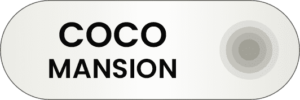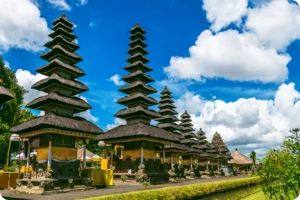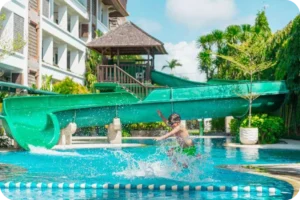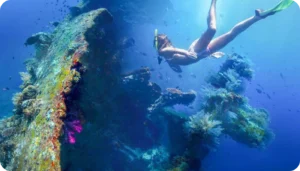When it comes to world-class surfing destinations, Bali stands in a league of its own. Revered as a surfer’s paradise, this magical island lures wave seekers from across the globe with its unbeatable combination of year-round swell, bath-warm waters, and a coastline that offers an incredible variety of surf breaks.
Whether you’re a total beginner eager to catch your very first wave or a seasoned shredder chasing hollow barrels, Bali delivers in ways few places can. From the iconic reef breaks of Uluwatu to the beginner-friendly waves of Kuta Beach, every corner of the island offers its own distinct rhythm, character, and challenge. Add to that the breathtaking tropical backdrops, laid-back beach vibes, and welcoming surf culture, and you’ve got more than just a surf trip—you’ve got an unforgettable adventure.
This guide highlights the top 10 surfing spots in Bali, organized by skill level to help you find the perfect wave for your style and ability. So whether you’re planning your first surf holiday or looking to explore new breaks, let this list be your compass to discovering the very best of Bali’s surf scene.
Understanding Bali’s Surf Seasons
But before grabbing your board and paddling out into Bali’s warm tropical waters, it’s essential to understand how the island’s seasonal patterns affect wave conditions. That is, Bali’s location in the heart of the Indonesian archipelago makes it a year-round surfing destination, but the two primary seasons—dry and wet—play a major role in determining the best surf spots, wave quality, and crowd levels.
Dry Season (April to October)
The dry season in Bali is widely regarded as the peak surfing season. During these months, the island experiences consistent swells generated by Southern Hemisphere storms. The southeast trade winds dominate, creating steady offshore winds along the western coast. These offshore winds groom the waves, making them clean, well-shaped, and ideal for both intermediate and advanced surfers seeking long rides, barreling sections, and powerful breaks.
Wave consistency is also high during this season, with multiple swells arriving regularly. The ocean tends to be more energetic, offering medium to large wave sizes. Surf schools, camps, and competitions often schedule their programs during this period due to the reliability of the conditions. Additionally, water temperatures remain warm and inviting, allowing for long sessions without the need for wetsuits.
However, because this season coincides with peak tourism, many surf spots become more crowded. In turn, accommodations, surfboard rentals, and surf lessons may also be slightly more expensive, so booking in advance is often recommended.
Own your COCO property in paradise with benefits for life
- +200 properties in construction
- +250 properties in full operation
- Pay 20% of your property straight from rental profit
Wet Season (November to March)
Though commonly viewed as the “off-season,” the wet season still offers solid surf potential, especially for those willing to explore less-crowded lineups and early-morning glassy waves. During this time, the prevailing winds shift and begin to blow from the west, causing onshore conditions on Bali’s western coast but creating clean offshore waves on the opposite side of the island.
Swell consistency tends to drop slightly compared to the dry season, but there are still regular waves, particularly during the peak of the monsoon. Rainfall becomes more frequent, usually occurring in short, intense bursts in the afternoon or evening, leaving the mornings calm and ideal for surfing.
The waves during the wet season are generally smaller and more manageable, which can be appealing for beginners or those looking to refine their skills in less intimidating conditions. The reduced crowds also provide a more relaxed, uncrowded surf experience.
Despite the occasional tropical downpour, Bali’s water temperature remains warm year-round, and many surfers appreciate the more laid-back vibe of the island during these months. Lower accommodation prices and fewer tourists create an excellent opportunity to explore the surf culture in a quieter, more authentic setting.
Surfing Spots in Bali For Your Skill Level
Regardless of the weather or tides, choosing a surf spot that matches your skill level is key to staying safe and having fun. From mellow beach breaks to world-class reef barrels, Bali offers waves for every level if you know where to go.
Below are some of the best surfing spots in Bali organized by skill level to help you find your perfect wave.
Beginner-Friendly Spots
1. Kuta Beach (Kuta)

Kuta Beach is one of the most iconic surfing destinations in Bali and serves as a welcoming gateway for countless beginners. Located just a short drive from Ngurah Rai International Airport, this long, golden stretch of coastline has built a reputation as a surf training ground thanks to its gentle beach break, soft sand bottom, and year-round wave consistency. The waves here typically break in slow, rolling patterns, which provide ideal conditions for new surfers who are still mastering basic techniques. The expansive shore also offers ample space, so even on busier days, there’s room to find your own wave.
What sets Kuta apart is the density of surf infrastructure available to visitors. Dozens of reputable surf schools line the beach, many offering daily lessons, board rentals, and guided surf experiences tailored for beginners. Whether you’re traveling solo, in a group, or with family, there’s no shortage of qualified instructors ready to help you catch your first wave. The area is also dotted with surf shops offering everything from foam boards and wetsuits to rash guards and accessories, as well as beachside warungs, cafés, and budget to mid-range accommodations that cater to surfers’ needs.
Beyond its beginner appeal, Kuta Beach is surrounded by a variety of surf breaks that cater to intermediate and even experienced surfers. These spots offer more speed, size, or technical challenge, and are accessible either by paddle out or via a quick boat ride from shore. Here’s a breakdown of notable nearby breaks:
- Kuta Reef: Located approximately 800 meters offshore from the southern end of Kuta Beach, Kuta Reef is accessible by boat and features fast, hollow left-hand waves that are best suited for intermediate to advanced surfers.
- Middle Reef: Situated between Kuta Reef and Airport Lefts, Middle Reef picks up more swell than neighboring breaks and performs best at low tide. It offers a more powerful wave that can hold its shape well.
- Halfway: As its name suggests, Halfway is found midway between Kuta Beach and Legian. It’s a favorite among both locals and tourists due to its balanced wave, which is great for progressing surfers who have moved beyond whitewater practice.
- Padma Beach and North Legian: Located just north of central Kuta, these sections produce punchier waves and are less crowded than the main beach, making them attractive for more confident beginners and intermediates.
- Airport Lefts: Found on the southern side of the airport runway, this reef break is a popular spot among intermediate surfers. It’s best accessed by boat and offers clean left-handers in the right conditions.
Surf conditions in Kuta are at their best during the dry season, from April to October, when early morning offshore winds help groom the waves into smooth, surfable lines. Small to medium southwest swells dominate this time of year, ideal for novice surfers looking to ease into the sport. With its blend of accessibility, gentle waves, surf-focused amenities, and a selection of more advanced breaks nearby, Kuta Beach remains one of Bali’s most versatile and enduring surf spots. Whether you’re standing on a board for the first time or refining your bottom turn, this bustling beach town offers a consistent, supportive environment to enjoy the ride.
- Location: Jl. Pantai Kuta, Kelurahan Kuta, Kecamatan Kuta Selatan, Kabupaten Badung, Bali 80361
- Surf Schools On-Site: Yes
- Best Conditions:
- Swell: Small to medium southwest swells
- Wind: Light offshore winds, typically in the early morning
- Tide: Mid to high tide for optimal wave shape
Own Your Bali Paradise Home With Zero Hassle
From land acquisition to construction and property management, we handle every detail. You simply reap the rewards.
2. Legian Beach (Legian)

If you’re seeking a beginner-friendly surf beach with a bit more breathing room than Kuta, Legian Beach should be high on your list. Just north of Bali’s most famous surf stretch, Legian offers a slightly less crowded, more relaxed atmosphere while still delivering reliable wave conditions that cater well to novice and progressing surfers.
As a surfing spot, Legian Beach features a long stretch of soft, sandy shoreline paired with consistent beach break waves, making it an ideal training ground for beginners and lower-intermediate riders. The whitewater near the shore provides excellent practice terrain for first-timers, while those ready to take on green waves will find more playful left and right peaks forming during the right tides. Although the break is generally mellow, Legian does receive more swell than neighboring Kuta, meaning wave sizes can be noticeably larger on some days, which helps surfers level up when conditions are manageable.
The best surf at Legian typically occurs during mid to high tide, especially in the dry season when southeast to northeast trade winds create clean, offshore conditions. However, low tide often produces heavier closeouts and unpredictable wave shapes due to shifting sandbanks. During the wet season, onshore winds can affect wave quality and bring debris onto the beach, making it less ideal for surfing.
Like Kuta Beach, Legian is also lined with an impressive array of surf schools, experienced local instructors, and convenient board-rental stands, so newcomers can book lessons or gear up within minutes of arriving. It still pulls a crowd when the swell is pumping, but the lineup remains noticeably looser than Kuta’s, giving learners and lower-intermediate surfers extra space to paddle, experiment, and progress. So, for anyone seeking a calmer first taste of Bali’s surf culture without compromising on wave quality, Legian delivers an ideal middle ground.
- Location: Jl. Melasti, Legian Kelod, Legian Kuta, Bali 80361 Indonesia
- Surf Schools On-Site: Yes
- Best Conditions:
- Swell: Small to medium southwest swells
- Wind: Light offshore winds
- Tide: Mid tide for the best wave quality
3. Batu Bolong (Canggu)

Another surfing spot that consistently delivers for beginners is Batu Bolong Beach in Canggu. This laid-back stretch of coastline is a favorite among longboarders and novice surfers thanks to its long, gentle waves and sandy entry that gradually transitions into a forgiving reef bottom. The wave here is mellow by Bali standards, offering a slow pace perfect for refining balance and positioning—ideal for those just getting comfortable riding unbroken waves. Even though it can get crowded, the atmosphere remains friendly and supportive, with plenty of space to paddle out during the quieter hours. The beachfront is also lined with surf schools, cafes, and rental shops, creating a vibrant and accessible hub for new surfers.
Batu Bolong is part of a cluster of surf breaks in the Canggu area, each offering something slightly different:
- Old Man’s: Located right next to Batu Bolong, this semi-reef break offers soft, rolling lefts and rights that are a step up in speed while still remaining beginner-friendly. It’s a great spot for surfers transitioning from whitewater to green waves.
- Canggu River Mouth: This is where things get more advanced. Known for its punchy, hollow right-handers, the River Mouth is a go-to for intermediate and experienced surfers, especially on a mid to high tide when it can barrel and hold up to 1.5x overhead on bigger swells.
- The Sandbar: Occasionally forming between Old Man’s and the River Mouth, the Sandbar offers short, peaky waves that can be fun and manageable on smaller days. It’s a good alternative when the other spots are too crowded or intense.
With small to medium southwest swells, light offshore winds, and a mid to high tide, Batu Bolong delivers some of the most consistent and approachable waves for beginners in Bali. The combination of friendly conditions, quality surf schools, and a lively social vibe makes it a perfect base for learning and progressing your skills.
- Location: Jalan Pantai Batu Bolong, Canggu, Badung, Bali 80361
- Surf Schools On-Site: Yes
- Best Conditions:
- Swell: Small to medium southwest swells
- Wind: Light offshore winds
- Tide: Mid to high tide for optimal wave shape
Intermediate Surfing Spots
4. Balangan Beach

For surfers looking to escape the more commercialized breaks and challenge their skills along Bali’s southern coastline, Balangan Beach offers both a scenic escape and a rewarding surf experience. While it’s well-loved by beachgoers for its pristine white sand and crystal-clear turquoise waters, Balangan has earned a loyal following among surfers for its reliable left-hand reef break. Best suited for intermediate riders, the wave offers fast, steep rides that, under perfect conditions, can stretch beyond 300 meters. The wave is generally fast and can close out quickly if you’re not keeping pace, but when timed right, it provides clean sections for maneuvers and even the occasional barrel near the peak.
This break handles medium to large south-southwest swells well, with easterly trade winds providing the best offshore conditions. While it can be surfed at all tides, mid to high tide is preferable to avoid the sharp coral reef underneath, which becomes more exposed during low tide. Booties are recommended due to the reef’s jagged nature. Although not suitable for beginners, Balangan’s waves are manageable for those with experience and offer a great opportunity to work on speed and positioning without the intense crowds found at some nearby Bukit spots. Amenities are simple but adequate, with a few warungs lining the cliff offering food, drinks, and a laid-back post-surf atmosphere.
- Location: Jl. Pantai Balangan, Jimbaran, South Kuta, Badung Regency, Bali 80364
- Surf Schools On-Site: Yes
- Best Conditions:
- Swell: Medium to large south-southwest swells
- Wind: Easterly trade winds
- Tide: Mid to high tide to avoid the shallow reef
why investors choose
coco development group?

Passive income on full auto pilot
Profit Maximization
We do not just put your property on Airbnb hoping for a guest to book it. More than 40% of our bookings comes today through our own medias, a strong community and a digital and data driven management approach.
A Convenient and fast payment system
The investors receive net profits currency that is convenient for them. we transfer the money once every three months
No need to handle taxes
High Liquidity
Fast Payback
Oceanside villas in Bali are in High demand for daily rentals. You will earn about 5000 USD per month
5. Echo Beach (Canggu)

For surfers seeking a lively and consistent break in Bali’s bustling Canggu area, Echo Beach delivers a dynamic lineup of waves with a distinct local flavor. This stretch of black sand is famed not just for its surf but also for the surrounding café scene, where beachgoers can sip coffee just steps from the action. Echo Beach serves up a mix of lefts and rights over a shallow reef, making it a top choice for intermediate to advanced surfers looking for more punch than the softer waves at neighboring Batu Bolong.
The main surf spots here each offer a unique experience:
- Stairs (Echo Beach Left): This powerful left-hand wave breaks over a shallow reef and is best surfed at mid to high tide. It’s known for its barrelling sections and consistent shape, making it ideal for surfers who enjoy pushing their performance. With its close proximity to beachfront cafes, it’s also one of the most photogenic and spectator-friendly surf spots in Canggu.
- Echo Reef: A classic left-hand reef break that works best when the tide is high enough to safely cover the jagged volcanic reef. It offers long, peeling walls that stretch for about 60 meters, making it perfect for surfers looking to carve and link maneuvers. The takeoff zone is wide, which helps a bit with the crowd, though competition for waves remains fierce.
- The Sandbar: Known for its mix of lefts and rights, The Sandbar is more forgiving than Stairs or Echo Reef, especially on smaller days. It’s a great option for intermediate surfers looking to test their skills on punchy, mid-sized waves without the same level of exposure to the reef.
Echo Beach’s consistency, variety, and access to post-surf hangouts make it one of Bali’s favorite breaks. To get the most out of your session, aim for a rising tide with light offshore winds—and be ready to hustle for your spot in the lineup.
- Location: Jalan Pura Batu Mejan, Canggu, North Kuta, Badung Regency, Bali 80361
- Surf Schools On-Site: Yes
- Best Conditions:
- Swell: Medium southwest swells
- Wind: Light offshore winds
- Tide: Mid to high tide for optimal wave shape
6. Medewi

If you’re craving long, laid-back rides and a break from the more chaotic surf hubs in Bali, Medewi Beach might be your perfect match. Tucked away on the island’s quieter west coast, this hidden gem offers a surf experience that’s as rewarding as it is peaceful. As a surf spot, it is known for having the longest left-hand point break in Bali which can stretch out for up to 500 meters, giving intermediate surfers all the space they need to fine-tune their turns and cutbacks.
The wave is mellow but consistent, best surfed during mid to high tide with light offshore winds in the early morning. Goofy-footers, in particular, will love the long, peeling shoulders that allow for stylish, drawn-out lines rather than short, punchy maneuvers. And although the beach itself is rocky with a cobblestone bottom and black sand, it carries a laid-back, Southern California feel—minus the crowds. The reef isn’t overly dangerous, but reef booties are strongly recommended due to sharp rocks and the occasional sea urchin, especially when entering or exiting the water.
Perhaps the only “downside” is the travel to the surf spot itself as it requires a bit of effort—about a 2- to 3-hour drive from Kuta—but surely the journey is worth every minute. The beach rarely feels packed, and even on busier days, the surrounding coastline is dotted with untapped river mouths just waiting to be surfed. With its tranquil setting, consistently surfable waves, and those famously long lefts, Medewi stands out as the perfect place to slow down, stretch out your rides, and reconnect with why you fell in love with surfing in the first place.
- Location: Jl. Pantai Medewi, Medewi, Pekutatan District, Jembrana Regency, Bali 82262
- Surf Schools On-Site: Yes
- Best Conditions:
- Swell: South to southwest swells
- Wind: Light offshore winds, typically in the early morning
- Tide: Mid to high tide for better wave shape and easier entry/exit
Advanced Surfing Spots
7. Uluwatu

If you’re chasing the heart of Bali’s surf culture and looking to test your skills on world-class waves, Uluwatu delivers a challenge like no other. Set beneath dramatic cliffs on the island’s southern tip, Uluwatu is a legendary surf destination, famous for its raw power, stunning scenery, and connection to Bali’s spiritual heritage. The breaks here are fast, heavy, and demanding—ideal only for advanced to expert surfers. Though crowded, the atmosphere is electric, and the view of the Uluwatu temple perched above adds a uniquely Balinese touch to every session.
Uluwatu’s wide reef hosts five main peaks, each with its own character and ideal conditions:
- The Peak: Located directly in front of the cave entrance, this is Uluwatu’s most consistent wave. It works best at mid to high tide and can offer barreling sections, especially during a solid swell.
- Racetracks: True to its name, this section offers a fast, hollow wave that races down the reef. It’s best surfed at low tide for advanced surfers who can handle quick takeoffs and tight barrels.
- Outside Corner: This is where Uluwatu truly shines during big south to southwest swells. The wave walls up and peels for hundreds of meters, making it a favorite for experienced surfers chasing long, powerful rides.
- Temples: A less crowded option further up the reef, Temples require a bit more paddling to access but offer clean, rippable waves when conditions align. It’s a great spot when the other peaks get too busy.
- The Bombie: Reserved for only the most experienced surfers, this deep-water slab comes alive during massive swells, producing thick, heavy waves that can rival the power of any big wave spot in the world.
To access the lineup, surfers paddle through the beach cave where strong currents can be tricky, especially during larger swells. The best surf rolls in with large southern or southwestern swells, easterly trade winds, and a mid to high tide to avoid the dangerously shallow reef. With its powerful waves and iconic setting, Uluwatu is more than just a surf spot—it’s a proving ground for surfers who want to experience the raw essence of Bali’s surfing soul.
- Location: Bukit Peninsula, Bali
- Surf Schools On-Site: Yes
- Best Conditions:
- Swell: Large south to southwest swells
- Wind: Easterly trade winds
- Tide: Mid to high tide to avoid the shallow reef
Maximize Your ROI With Data-Driven Management
Benefit from our advanced marketing channels, strong community presence, and direct bookings that outperform standard Airbnb listings.
8. Padang Padang

If you’ve ever dreamed of catching the perfect barrel in a tropical paradise, Padang Padang is where that dream meets reality. Often called the “Balinese Pipeline,” this legendary break on Bali’s Bukit Peninsula is reserved for the boldest surfers. Set against a dramatic cliffside and accessed through a narrow cave entrance, the beach itself is stunning—but the main attraction is the left-hand reef break. On the right swell, long, hollow barrels thunder over a sharp, shallow reef, creating one of the most powerful and photogenic waves on the island. With swells reaching up to 12 feet, Padang Padang Left is a serious challenge, best tackled during large south-southwest swells, easterly trade winds, and a mid to high tide. It’s the kind of wave that can offer the ride of your life—or leave you with a broken board if you’re not careful.
Just next to this beast lies Padang Padang Right, affectionately known as Baby Padang. Breaking over a gentler section of reef, this mellow right-hander is ideal for beginners or intermediate surfers looking for a more forgiving ride in the same iconic setting. While the left is suited only for experts, Baby Padang provides a fun, smaller alternative with far less intensity. Together, these two breaks make Padang Padang a well-rounded destination, whether you’re chasing barrels or just beginning your surf journey.
- Location: Jalan Labuan Sait, Pecatu, Kuta Selatan, Badung, Bali, Indonesia, 80361
- Surf Schools On-Site: Yes
- Best Conditions:
- Swell: Large south-southwest swells
- Wind: Easterly trade winds
- Tide: Mid to high tide for safer conditions
9. Keramas

Keramas is a unique surf spot that stands out in Bali’s landscape, known mostly for its perfect lefts, by offering powerful right-hand barrels with raw east coast charm. Located along Bali’s striking black-sand shoreline, Keramas delivers steep drops, fast hollow sections, and open faces ideal for deep barrels and explosive maneuvers. Breaking over a shallow volcanic reef, the wave thrives on medium to large southeast swells combined with early morning offshore winds, producing heavy, consistent surf that challenges even the most skilled surfers.
Once a local secret, Keramas has evolved into a premier global surf destination and regular competition venue, attracting elite surfers worldwide. The break performs best at mid to high tide, providing longer rides and a slightly less punishing reef. Its strong currents and technical nature mean it’s suited only for advanced surfers. And for those seeking something different, night surfing is possible thanks to floodlights installed by nearby resorts!
- Location: Jalan Prof Ida Bagus Mantra,Jl Pantai keramas – Blahbatuh, Keramas, Bali 80581
- Surf Schools On-Site: Yes
- Best Conditions:
- Swell: Medium to large southeast swells
- Wind: Light offshore winds, typically in the early morning
- Tide: Mid to high tide to avoid the shallow reef
10. Bingin

Bingin is a breathtaking surf destination that delivers the kind of wave most surfers dream about: clean, mechanical left-hand barrels framed by a secluded beach and dramatic cliffside views. Tucked along the Bukit Peninsula just north of Uluwatu, Bingin’s wave may be short, but it packs a serious punch. It breaks over a sharp, shallow reef with a tight takeoff zone, offering a thrilling but unforgiving ride that rewards expert timing and precision. On a mid to low tide with medium to large south-southwest swells and easterly trade winds, Bingin transforms into a barrel machine, drawing skilled surfers eager to get slotted in its hollow green room.
Although the wave’s perfection is no secret, and crowds can be expected, the scenery alone makes the effort worthwhile. Accessible only by a steep staircase carved into the cliffs, Bingin Beach remains one of the most picturesque on the island. Its clear waters, peaceful warungs, and cliffside accommodations create a laid-back vibe that contrasts with the intensity in the water. For seasoned surfers who know how to navigate tight takeoffs and razor-sharp reefs, Bingin offers a world-class, adrenaline-pumping surf experience that’s as beautiful as it is challenging.
- Location: Jl. Pantai Bingin, Ungasan 80361, Bali,
- Surf Schools On-Site: Yes
- Best Conditions:
- Swell: Medium to large south-southwest swells
- Wind: Easterly trade winds
- Tide: Mid to high tide to cover the shallow reef
Construction you can trust
We handle all the details – no hassle for you.

5 Years full warranty

20+ Finished developments in Bali by our team

25+ Years of shared experience
Surfing Etiquette and Tips
Now that you know where to find Bali’s best waves, it’s just as important to understand how to surf them responsibly. Good surf etiquette not only keeps the lineup friendly, but also ensures your safety and the preservation of Bali’s pristine breaks.
- Respect the locals: Many surf spots, especially the more famous ones, have a strong local presence. Regulars often know the nuances of the break and the lineup flow. Wait your turn, observe the vibe, and show respect—a little courtesy goes a long way.
- Don’t drop in: Always check if someone is already riding the wave before paddling in. Dropping in on another surfer is not only dangerous, but one of the quickest ways to lose respect in the lineup.
- Know your limits: Bali offers some powerful, shallow reef breaks that are not beginner-friendly. If you’re unfamiliar with a spot, take time to watch the waves and how others surf it before paddling out. Don’t hesitate to ask for advice or even hire a local guide for your first session.
- Protect the reef: Many of Bali’s best waves break over living coral reefs. Avoid standing on or kicking the reef with your fins to protect both the ecosystem and yourself. Reef cuts are no joke and can quickly end your surf trip.
- Respect the rotation: In crowded lineups like Uluwatu or Bingin, there’s often an unspoken rotation system. Pay attention to who’s been waiting and don’t paddle around people just to get ahead.
- Stay calm in the chaos: Between strong currents, aggressive waves, and other surfers, Bali can get hectic. Keep your cool, avoid confrontation, and focus on enjoying the waves.
- Clean up after yourself: Whether you’re surfing or just hanging on the beach, always dispose of trash properly and leave the area cleaner than you found it.
FAQ
The dry season, especially between May and September, offers the most consistent waves and favorable conditions on the west coast.
Yes. Kuta Beach, Batu Bolong, and Legian are beginner-friendly spots with soft waves and surf schools.
It’s always safer to surf with a buddy, especially at reef breaks. For beginners, staying in surf school zones is advisable.
Absolutely. Rental shops are plentiful in popular areas like Kuta, Canggu, and Uluwatu. Prices range from $5 to $10 per day.
No. The water is warm year-round, so a rash guard is usually sufficient to protect from the sun and board rash.
Future-Proof Your Investment With High Liquidity
Our prime Bali locations drive property value growth by up to 35% upon completion, ensuring both strong appreciation and an easy sell if you choose to exit.
Chase Bali’s Waves and Find Your Break!
Whether you’re standing on a board for the first time or chasing barrels in one of the world’s most iconic reef breaks, Bali’s surf scene has something for you. With diverse wave types, seasonal variety, and vibrant beach culture, it’s no surprise Bali remains a top destination for surfers of all levels.
Most importantly, respect the ocean, follow proper surf etiquette, and take the time to understand each break. With the right mindset and a little local knowledge, you’ll find that surfing in Bali is not just about catching waves — it’s about becoming part of a timeless surf culture rooted in community, adventure, and connection to nature.

Rasmus Holst is a serial entrepreneur and Co-Founder of COCO Development Group, where he helps drive innovation and growth through strategic business development. He is also the Co-Founder of Estate of Bali and Regnskabshelten.dk, Denmark’s fastest-growing accounting firm, which grew to 35 employees and generated $2.5M in turnover in 2023. Rasmus is passionate about building businesses that create long-term value and impact.














